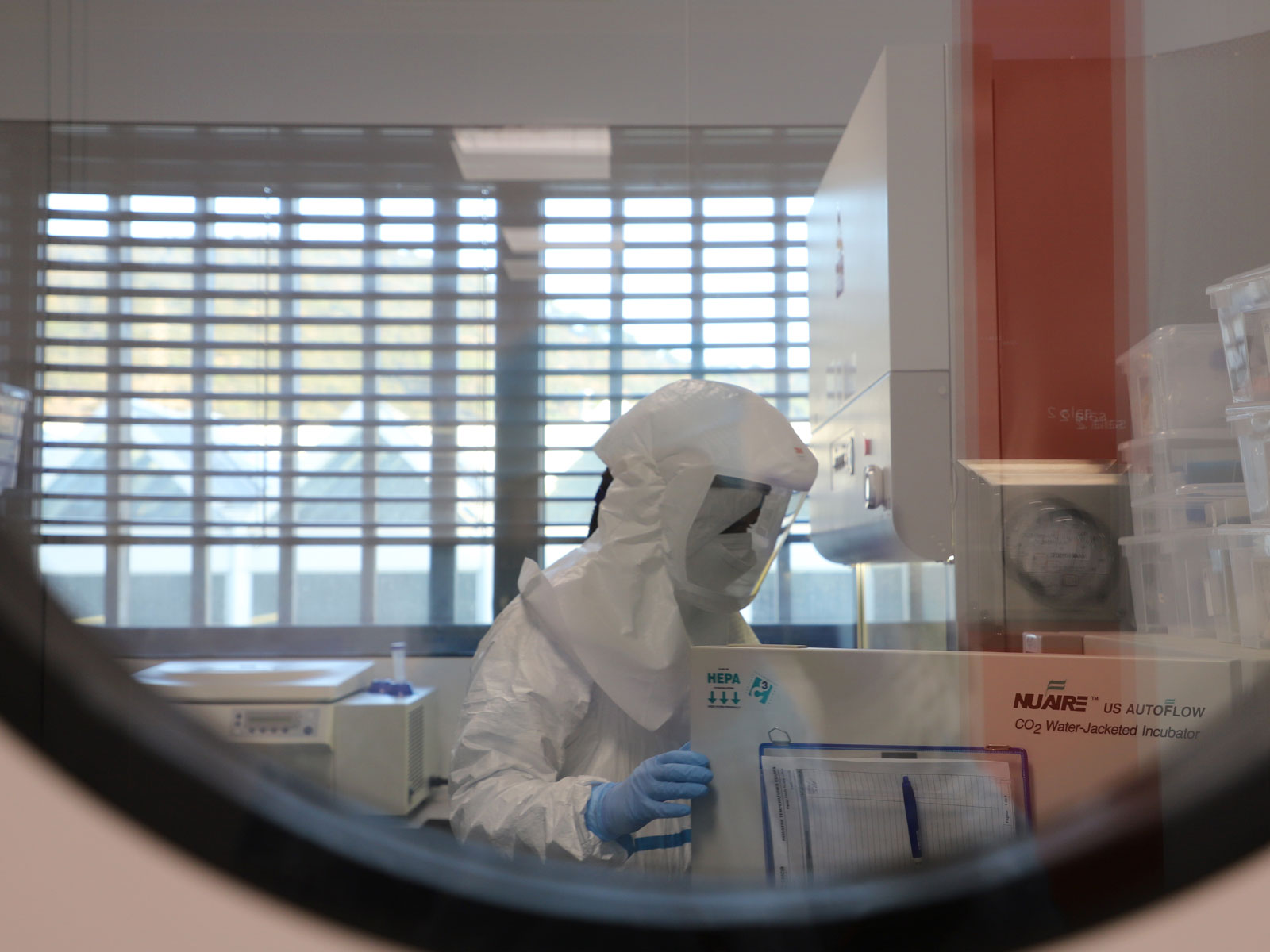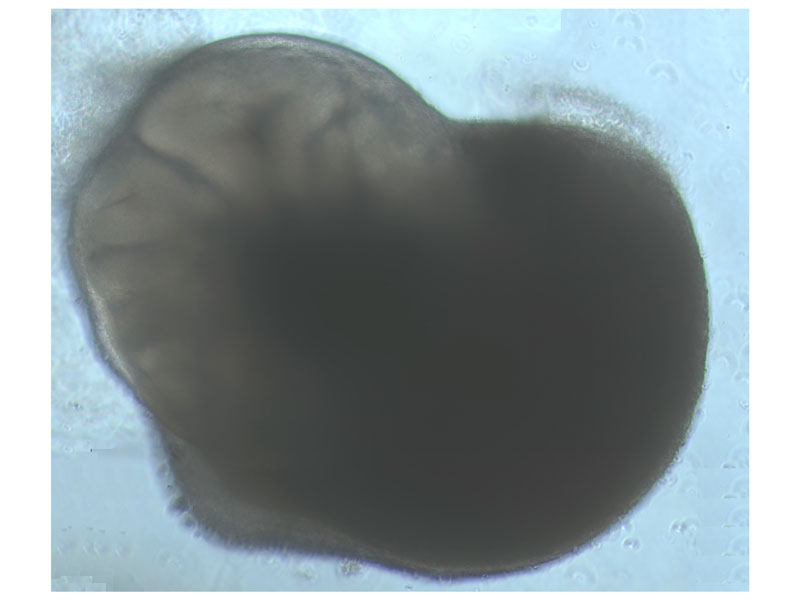The first projects on SARS-CoV-2 in lab-designed mini human organs gets underway

- The Centre for Comparative Medicine and Bioimage of Catalonia (CMCiB), of the Germans Trias i Pujol Research Institute (IGTP), will be the second centre in Catalonia to work on the SARS-CoV-2 virus obtained directly from patients. Until now most work has taken place with artificial viruses that can only infect once
- Research staff of IrsiCaixa and the Institute of Evolutionary Biology (IBE) have started to work on the virus in the CMCiB to study the infection of organoids; mini organs designed in the laboratory to simulate human lungs and brains
- Organoids are already being used in research and their use in studies into COVID-19 will provide better understanding of infection by SARS-CoV-2 and the capacity of different drugs to eliminate it from these tissues
For the results of research to be applicable to humans, the models used must be as close as possible to us. Researchers at IrsiCaixa, a centre supported by the "la Caixa" Foundation and the Ministry of Health of the Government of Catalonia; and the Institute of Evolutionary Biology (IBE), a mixed centre of the Universitat Pompeu Fabra (UPF) and the Spanish National Research Council (CSIC), have started a new project on lung and brain organoids designed in the laboratory, which will allow the most realistic simulation possible of infection by SARS-CoV-2. The study will be carried out with SARS-CoV-2 virus obtained from patients, which reflects the reality of infection a lot better. They are an alternative that will substitute the widely used artificial viruses, which have been modified to prevent them from replicating.
This strategy is possible thanks to the facilities at the CMCiB, of the IGTP, which has animal biosecurity level 3 (ABSL3) laboratories, recently equipped and prepared to offer the strictest biosafety conditions required to work with SARS-CoV-2 from patients. This makes the CMCiB the second centre in Catalonia to work on "real SARS-CoV-2 virus", an important service that allows researchers on the Can Ruti Campus to take on new projects aimed at finding diagnostics and treatments for COVID-19. The final objective is to study how this virus affects human organs and the effectiveness of various drugs at halting the infection. This is possible thanks to the use of artificial intelligence (AI), that can detect to what degree the mini organs are affected by the infection and the role of the drugs in each case.
"SARS-CoV-2 is a virus that is transmitted through the air, because of this, it has been necessary to adapt the high-level biosecurity level facilities for this factor and offer adequate training to all the research staff who come to work on these projects. Now, not only can we study how the real infection develops, but we are also preparing to work on other similar viruses," explains the Director of the CMCiB and the Chairman of the Biosecurity Committee, Dr Pere-Joan Cardona. "Having these resources on the Can Ruti Campus means we can tackle much more ambitious projects in the area of infectious diseases. The fact that we are carrying out a project on organoids also means that the results are as similar as possible to the equivalent in humans, and this is vital," adds ICREA Research Professor at IrsiCaixa Dr Javier Martínez-Picado. Organoids, which have already been used previously in research, are mini-organs of a few millimetres in diameter. These are usually created from stem cells and have the potential to form any human organ. In this case, they will form mini lungs and brains.

Laboratory for research into infectious diseases
The level three animal biosecurity laboratories (ABSL3) are adapted so that research staff can work with certain biological agents that cause infectious diseases in people, particularly those with greater risk of transmission in aerosols, such as SARS-CoV-2. The ABSL3 area at the CMCiB, which already houses studies focused mainly on AIDS and tuberculosis, has now taken another step to adapt the facilities to be able to work on active SARS-CoV-2 virus; this includes, for example, incorporating autonomous ventilators in the changing room for researchers.
"The CMCiB started working as a reference centre for comparative medicine in 2018; with research areas prepared for three different levels of biocontainment," explains Sara Capdevila, Technical Director of the CMCiB. "But above all, it is a centre dedicated to promoting alternatives to animal models, such as bioimaging and computational models, following a 3R policy: replace, reduce and refine," she underlines. The 3R Programme at the CMCiB, has the support of "la Caixa" Foundation, which provides the centre with the resources needed to bring about the consolidation of alternative research models.
Situated at the top of the Can Ruti Campus for Health Research of Excellence, the CMCiB provides a service to other projects that also use replicating SARS-CoV-2 virus.
The ABSL3 section dedicated to research into infectious diseases also hosts projects focused on other diseases transmitted by air, such as tuberculosis. "Our group is working on different in vitro cellular models to study the impact of external factors on the immune response to the pathogen. The facilities at the CMCiB make the advance to animal models, or alternative models much easier,"explains Dr. Jose Domínguez, Group Leader of the Innovation in Respiratory Infections and Tuberculosis Diagnosis research group.
Organoids as human models for research
In line with the concept of 3R, organoids permit research to advance by using them as alternative models to meet different biomedical challenges. They can replace animal models, which would have been used to develop the studies. The project, which was initiated by researchers of IrsiCaixa and the IBE is based on generating mini-lungs and mini-brains in the laboratory, produced from stem cells. Healthy mini-organs will be infected with SARS-CoV-2 and the level of deterioration will be evaluated. Previously, they will have been treated with drugs that are potentially effective against the virus, so they can be followed up to see which drugs prevent the virus from replicating.
"We will analyze the effect of the infection on humans using molecular techniques. Additionally, we will use microscopic photographs of the organoids in each phase of the infection to monitor the evolution of the infection using an artificial intelligence algorithm, designed in collaboration with Dr Lao of the CNAG-CRG (Centre Nacional d'Anàlisi Genòmica - Centre de Regulacio Genòmica). This system will recognize patterns of infection and we will be able to rapidly evaluate which drugs are working better," explains Dr Sandra Acosta, the researcher in charge of the project at the Institute of Evolutionary Biology (IBE).
Completing this collaborative Project will allow the research staff to better describe the functioning of SARS-CoV-2 in the human body, particularly in brain and lung tissue. Establishing the process the virus follows when it infects these organs is key to be able to design more effective vaccines and find effective treatments against SARS-CoV-2.
